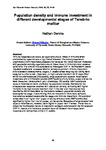Population density and immune investment in different developmental stages of Tenebrio molitor
| dc.contributor.author | Dennis, N. | |
| dc.date.accessioned | 2020-10-10T18:35:03Z | |
| dc.date.available | 2020-10-10T18:35:03Z | |
| dc.date.issued | 2020 | |
| dc.identifier.citation |
Dennis, N. (2020) ‘Population density and immune investment in different developmental stages of Tenebrio molitor’, The Plymouth Student Scientist, 13(1), p. 45-63. | en_US |
| dc.identifier.uri | http://hdl.handle.net/10026.1/16505 | |
| dc.description.abstract |
Immune responses are costly, so organisms should invest in immunity when environmental cues indicate a high risk of infection. The density-dependent prophylaxis (DDP) hypothesis proposes that because the risk of infection increases with population density, organisms should invest more in immunity under crowded conditions. The aims of this study were to investigate DDP in the mealworm beetle Tenebrio molitor and to assess whether density-dependent immune investment differs between developmental stages. T. molitor larvae weighing 50-130mg were assigned to either a low-, moderate-, or high-density treatment for 31 days. After which the phenoloxidase (PO) activity, encapsulation and capsule melanisation responses, and antimicrobial peptide (AMP) activity of any larvae, pupae and adults were measured. Development, adult phenotype, PO activity, AMP activity and capsule melanisation were unaffected by population density. Additionally, the encapsulation response declined with population density, coinciding with higher mortality in the high-density treatment than in the low- and moderate-density treatments. While there were no interactions between population density and developmental stage in determining immune investment, there were complex relationships between developmental stage and immune investment. PO activity of larvae was much higher than pupae or adults, whereas larval AMP activity was significantly higher than that of pupae, but not adults. Measures of encapsulation and capsule melanisation, however, were higher in pupae than in larvae. These results reflect the multifaceted nature of insect anti-pathogen defences and the intricacies of DDP in insects, and indicate a possible trade-off between the encapsulation response and competitive ability in T. molitor. | en_US |
| dc.language.iso | en | en_US |
| dc.publisher | University of Plymouth | en_US |
| dc.rights | Attribution 3.0 United States | * |
| dc.rights.uri | http://creativecommons.org/licenses/by/3.0/us/ | * |
| dc.subject | Population density | en_US |
| dc.subject | immune investment | en_US |
| dc.subject | Tenebrio molitor | en_US |
| dc.subject | density-dependent prophylaxis | en_US |
| dc.subject | DDP | en_US |
| dc.subject | antimicrobial peptide | en_US |
| dc.subject | phenoloxidase | en_US |
| dc.subject | T. molitor larvae | en_US |
| dc.subject | anti-pathogen | en_US |
| dc.subject | T. molitor | en_US |
| dc.subject | larvae | en_US |
| dc.title | Population density and immune investment in different developmental stages of Tenebrio molitor | en_US |
| plymouth.issue | 1 | |
| plymouth.volume | 13 | |
| plymouth.journal | The Plymouth Student Scientist |



